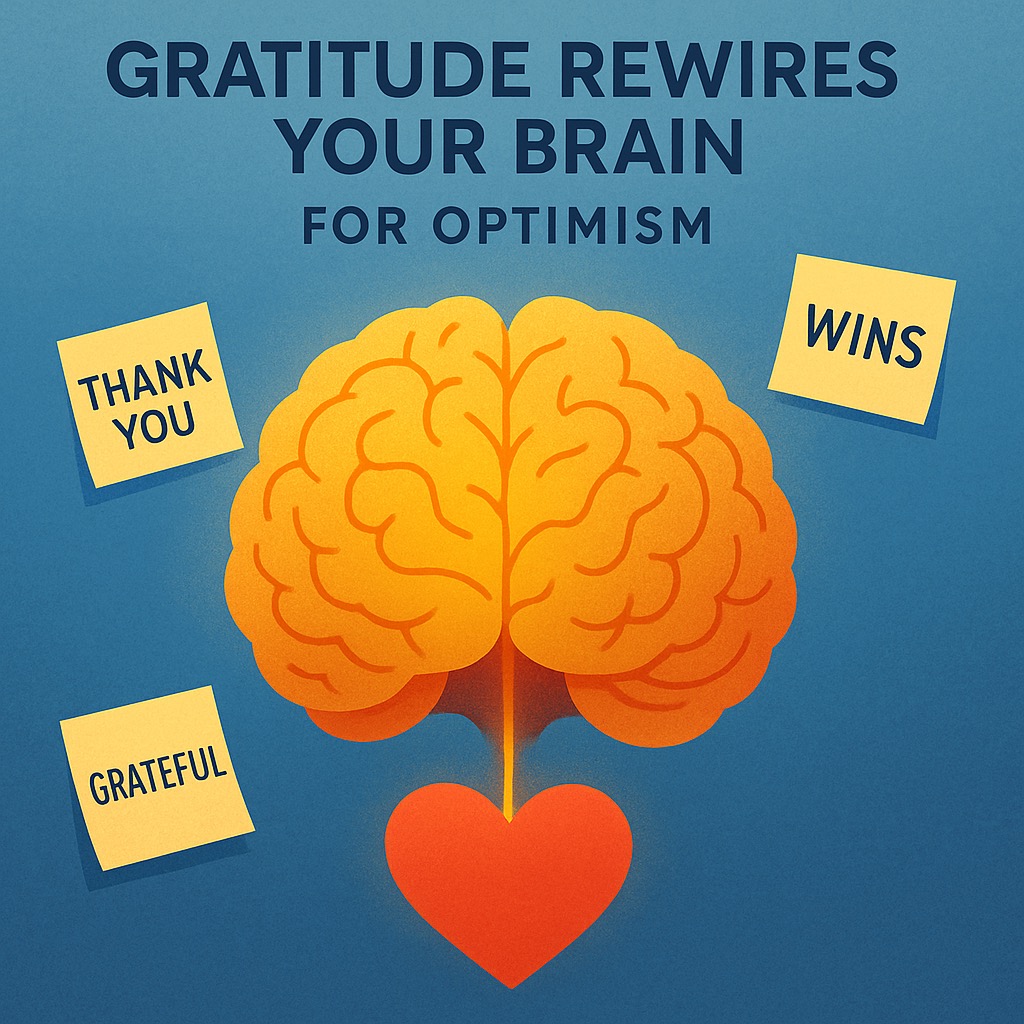When people talk about gratitude, it's often framed as a "soft skill" — a feel-good ritual that sits somewhere between mindfulness and journaling. But neuroscience tells a much deeper story: gratitude literally rewires the brain to tilt us away from fear-driven survival patterns and toward opportunity-focused leadership.
The Neuroscience of Gratitude
Gratitude journaling engages key neural circuits linked to reward and resilience. Writing down things you are thankful for activates the ventral striatum and medial prefrontal cortex — regions tied to reward anticipation, motivation, and mood regulation. Over time, this practice dampens the amygdala's bias for scanning threats, shifting your baseline orientation toward rewards and positive cues.
This is more than emotional hygiene. Research shows that consistent gratitude practice reduces cortisol levels and strengthens immune function, creating a physiological buffer against stress. In other words, gratitude doesn't just "make you feel better"; it makes you measurably more resilient.
Journaling as Neural Training
In the course module, gratitude journaling is presented as one of four high-impact journaling formats alongside "morning pages," mood tracking, and goal-focused logs. Each method works on different aspects of cognition, but gratitude logs have a unique role: they retune the brain's selective attention filters to spot resources and opportunities that would otherwise be discarded in the 90% of sensory data the brain routinely ignores.
Stacking practices amplifies the effect. For example:
- Morning pages: Clear mental clutter (reducing default rumination)
- Gratitude line: Tilts your neural valence positive
- Goal tag: Signals the reticular activating system what to prioritise that day
This micro-stack of writing practices builds executive bandwidth, reduces emotional hijacking, and sets up leaders to operate from a state of abundance rather than scarcity.
Why Gratitude Matters for Leaders
Leadership is, at its core, about attention. Where you place your focus — threats or opportunities — cascades through your team. Neuroscience shows that humans are socially contagious creatures: optimism and positivity spread through mirror neuron systems as effectively as fear and negativity do.
When leaders close their day with two small gratitude notes, they prime their brain to carry optimism into sleep, consolidating positive patterns overnight. When they then share one gratitude with their team weekly, they normalise reflection, model vulnerability, and signal abundance.
The ripple effect is profound: teams led by gratitude-oriented leaders report higher trust, greater psychological safety, and improved performance outcomes.
Gratitude as an Antidote to Loss Aversion
One of the most persistent biases in business is
loss aversion: the brain weighs potential losses 2–2.5 times more heavily than equivalent gains. Left unchecked, this bias makes leaders risk-averse, defensive, and less innovative.
Gratitude counters this by actively rewiring value-tagging circuits in the brain. By keeping a written achievements list or practising an "abundance audit" (replacing every negative snapshot with a gain-centric counter-thought), leaders recalibrate their mental weighting system. Over time, they build the resilience and cognitive flexibility needed to lead bold bets, not just safe plays.
Practical Gratitude Habits for Busy Leaders
Here are science-backed habits you can implement immediately:
- Nightly Gratitude Log: Write down two wins or resources before bed. This primes your prefrontal cortex to notice opportunities and wires optimism overnight.
- Weekly Team Gratitude Share: Ask each team member to share one small win at the end of the week. This injects dopamine into the group dynamic and normalises positive recall.
- Abundance Flip: When a scarcity thought pops up ("We're under-resourced"), deliberately write its abundant counter ("This constraint forces us to innovate leaner solutions").
- Leadership Intention + Gratitude Stack: Pair your gratitude notes with one leadership intention ("I create psychological safety in meetings"). Spoken aloud, this activates motor, auditory, and language circuits simultaneously — a multi-channel signal that the brain encodes as significant.
Closing Thought
Gratitude isn't just a wellness buzzword. It's a neuro-leadership strategy that optimises circuitry for resilience, opportunity detection, and social influence. For leaders navigating today's volatile cycles, cultivating gratitude is not a luxury — it's a competitive advantage.
Key Insight: Until you deliberately overwrite scarcity reflexes with abundant framing, your brain will keep replaying yesterday's fears. Gratitude is one of the simplest, most effective tools to take that control.
Additional Resources
Neuroscience for Business Online Short Course - MIT Sloan's comprehensive program for a deeper dive into neuroscience applications in business, featuring insights on gratitude and neural rewiring for leadership effectiveness.
Connect with Us
See this post on our LinkedIn - Check out our latest insights on applying neuroscience principles to build gratitude-based leadership and competitive advantages.
Follow us for more insights on neuroscience for business, leadership optimization, and AI-driven productivity strategies!
